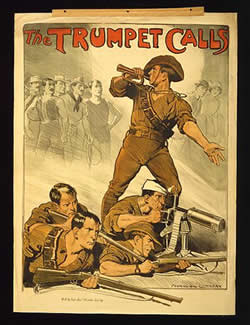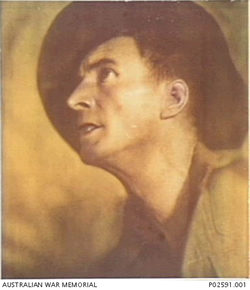History Stage 5
Overview

Australian Army recruitment poster from the First World War
©Public Domain (Library of Congress)
Using a variety of primary and secondary sources, students investigate how and why Australians commemorate wars and the ways in which specific wars and campaigns are recognised. Using a range of sources, students explore varying perspectives on the Anzac legend, including that of Aboriginal and Torres Strait Islanders. Students develop and communicate their own and other perspectives.
Teaching and learning activities

'The spirit of Anzac' or 'The Digger' by Jack Cato
©Public Domain (AWM P02591.001)
Question: How and why do Australians commemorate the First and Second World Wars? What are the different perspectives on the Anzac legend?
Activity 1 – Introduction
Source 1: Andrew Denton’s Gallipoli: Brothers in Arms (ABC Splash video)
Use the ‘Things to Think About’ questions on the ABC Splash page as discussion starters on commemorations and the nature of the Anzac Legend.
Activity 2 – Commemorating the wars
Using Sources 1 to 4 and their own research, students outline the background to commemorations on Anzac Day and Remembrance Day in Australia. Students should include:
-
an explanation of what events we commemorate in each of these annual events
-
an explanation of why the commemorations are important for contemporary Australians
-
a comment on the usefulness and reliability of each source.
Source 2: The Dawn of the Legend (Australian War Memorial)
Source 3: The Meaning of Anzac Day (ABC Splash video)
Source 4: Photograph of Anzac Day procession through the streets of Brisbane, 1916
Activity 3 – Perspectives on the Anzac legend
As alluded to in Source 5, there are varying perspectives on the Anzac legend. Some question why it is based in the Gallipoli campaign and not other major wars and battles involving Australian troops. Others feel it overlooks the Frontier Wars held on Australian soil and others state that the personal impact of war on service personnel from recent conflicts is not adequately recognised.
Students read Sources 5 to 8 and source media articles that provide alternative views on the Anzac legend. They make notes to chart the varying perspectives on the Anzac legend. Students also comment on the reliability of the sources. Students generate a source analysis table that:
-
paraphrases the source’s view on Anzac Day/Anzac legend
-
rates the source as biased, shows some bias, unbiased and why you think this
-
uses a rating scale to evaluate the usefulness of this source for historians.
Students design an infographic to be included in a booklet on Australia’s military history that explores the varying perspectives on the Anzac legend. Students should integrate source materials and add their voice to the debate and explain their own perspective.
Source 5: Extract from Anzac Spirit, Australian War Memorial, accessed 3 December, 2015
Legend and myth
Historians examining the importance of Anzac to Australia coined the phrase ‘Anzac legend’ (or, more critically, ‘Anzac myth’). This refers to the representation of Australians in war, how they think, speak, and write of their war experience (which is not always the same thing as how they experienced it).
Though aspects of the legend have been criticised, there is general consensus on what is regarded as the Anzac spirit. Anzac came to stand for the qualities which Australians have seen their forces show in war. These qualities collectively make up the Anzac spirit and include endurance, courage, ingenuity, good humour, and mateship.
Source 6: Extract from Anzac Day Speech, 2015 by David Singer, Vice President of the Returned Services League Western Australia North Beach Sub-Branch, served with the 1st Battalion of the Royal Australian Regiment in Afghanistan.
My time in Afghanistan defined what the ANZAC spirit means to me. It’s about freedom, courage, and standing up for those who can’t stand up for themselves. It’s about always having a smile on your face even through the toughest of times. And above all, just as was the case in Gallipoli and just as it has been in every conflict since, the ANZAC spirit is about the mates alongside you.
People are often confused when I talk about Afghanistan and I tell them that some of the greatest memories of my life are from one of the worst places on earth. It was dangerous, it was uncomfortable, at times it was seemingly never-ending. But, through it all, every single day, I was with my mates. Every day we looked out for one another and every day we went through the good times and the bad together.
We moved forward together, even when we were afraid because there is no way we would ever let each other down. And it is strange to say that even though we were in one of the most dangerous countries on earth, I often felt safer there than I have ever felt at any other point in my life. Because I knew that no matter what we did, or where we went, my mates were watching my back. And I knew that if something were to happen to me, and I had found myself on the ground, that nothing in that country would have been able to stop them from getting to my side.
Source 7: Extract from Commemorating the Anzac Legend Ain't that Bad by Peter Craven, The Drum, ABC, 25 April, 2011
Is the Anzac legend a ‘lie’? Well, it is a myth and myths are things which contain truths whether they have their basis in fact or in that fiction which the imagination has shaped.
It is a matter of fact that the experience of World War I was a terrible thing. It is a matter of fact that there are reports of the bravery and prowess of the Australian soldier—there is the whole Light Horse tradition—and there are the reports of the larrikinism and carefree quality of the diggers. It is a matter of fact that a lot of ‘uncles’ died in the Great War—there's also a Chris Wallace-Crabbe poem about it. It’s also true that the great aunts, so often maiden aunts, of a lot of people born in the 1950s were in fact women who lost their men in that war.
Of course mythology rings a thousand changes on such truths. Smaller countries, dominion countries that take their bearings from great empires, where the very language of thought is minted, tend to identify with stories of war just as the heroes of those cultures tend to be the heroes of the sports field.
Source 8: Extracts from Undeclared Frontier Wars March on Anzac Day by Joseph Walker, Sydney Morning Herald National, 24 April 2015
A small group of Indigenous Australians will march in Canberra on Saturday to remember the Indigenous people killed during the undeclared Frontier Wars.
Indigenous people were first killed by settlers in 1788, after Australia was settled by the British. In the proceeding centuries the colonial frontier pushed further and further inland, leaving a bloody trail of death and disease in its wake.
Anderson said remembering those who died was not the only reason for the marches. The other aim was to draw attention to the Indigenous people who had fought and died on behalf of the Australia in wars overseas.
The march was led by an Indigenous man, Michael Thorpe.
‘He had his grandfather's First World War medals on him, because his grandfather went and fought in that world war,’ Mr Anderson said.
Symbolically, Mr Thorpe carried a spear and a boomerang as well.
‘I had cousins and great uncles who went and fought in the Great War,’ Mr Anderson said. ‘They were in Gallipoli. They were in France and Belgium.’
Learning concepts
These additional questions can be used for discussion or further investigations.
Challenge
What challenges did Indigenous soldiers face on their return to the community? How were these experiences different to non-Indigenous service personnel?
Change
What changes have occurred in Anzac Day and Remembrance Day commemorations over the past 100 years? What changes may occur in the future?
Caring
What qualities of the Anzac legend encompass the concept of caring?
Community
What clubs, schemes, services and other support exist for returned service personnel?
Commemoration
How and why have Australians commemorated the wars?
What are the different perspectives on which wars Australians should commemorate? Should Anzac Day recognise the Frontier Wars fought in Australia?
Syllabus links
Depth Study 3: Australians at War: World Wars I and II (1914–1918, 1939–1945)
HT 5-4 explains and analyses the causes and effects of events and developments in the modern world and Australia
HT 5-5 identifies and evaluates the usefulness of sources in the historical inquiry process
HT 5-7 explains different contexts, perspectives and interpretations of the modern world and Australia
Commemorations and the nature of the Anzac legend (ACDSEH097)
Students:
-
explain how and why Australians have commemorated the wars
-
explain different perspectives on the Anzac legend